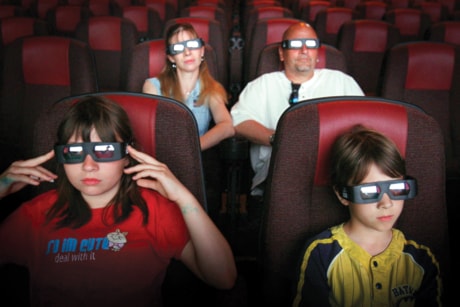SACO, Maine — To hear the folks in Hollywood talk about it, improved 3-D technology and the quality films that are quickly lining up behind it represent nothing short of a revolution.
Tell that to the folks who still live hours from the nearest 3-D-equipped theatre.
For them, all the extradimensional summer offerings and slick marketing campaigns amount to nothing more than a big, frustrating tease. For them, the movie world is still flat.
Because of the high cost of upgrading equipment, the vast majority of theatres don’t yet have the ability to show 3-D movies, a situation that affects the furthest-flung areas most.
Those who haven’t made the costly transition run the risk of losing customers who’re willing to travel to see it elsewhere in 3-D, said Bob Collins, marketing director of Zyacorp Entertainment’s Cinemagic, which has been offering 3-D at its Saco theatre for more than a year.
“A chain that doesn’t have the 3-D technology, they’re going to be in a very tough situation because they’re basically going to be turning away customers,” he said.
As it stands, 26 per cent of 5,756 cinemas across the United States have one or more screens capable of showing 3-D movies, but that number is expected to grow as financing becomes available later in the summer, said Patrick Corcoran from the National Association of Theater Owners.
All told, there were only 2,385 3-D screens out of a total of 38,853 screens across the United States at the end of May, according to the theatre group.
There would be thousands more screens converted to the format if not for the recession. Two separate financing deals that would’ve brought 3-D to more than 20,000 movie screens across the country collapsed because of the economic meltdown, Corcoran said.
And the technology doesn’t come cheap.
It costs about US$70,000 for a movie theatre to upgrade from film to a digital projector, and the 3-D add-on costs another $30,000.
That $100,000 total compares to the cost of $15,000 to $20,000 for a traditional 35 mm projector that has been the industry standard.
Upgrading all movie screens to the digital technology would cost billions, and the slow progress has created tension between studios and cinemas.
At last month’s Cannes Film Festival, Dick Cook, Disney studio chairman, made a friendly jab at cinema owners when he noted that Disney was able to have a makeshift theatre up and running in three days.
The company set up the screen at a Cannes hotel to show reporters 3-D footage of its new version of Charles Dickens’ A Christmas Carol, starring Jim Carrey and due in theatres late this year.
“It just dawned on me, this theatre that you’re in today, it’s digital, it’s 3-D, and we built it in three days,” Cook said. “Now I was just thinking to all the exhibitors that are here, it only took us three days. So let’s pick up the pace a little bit.”
